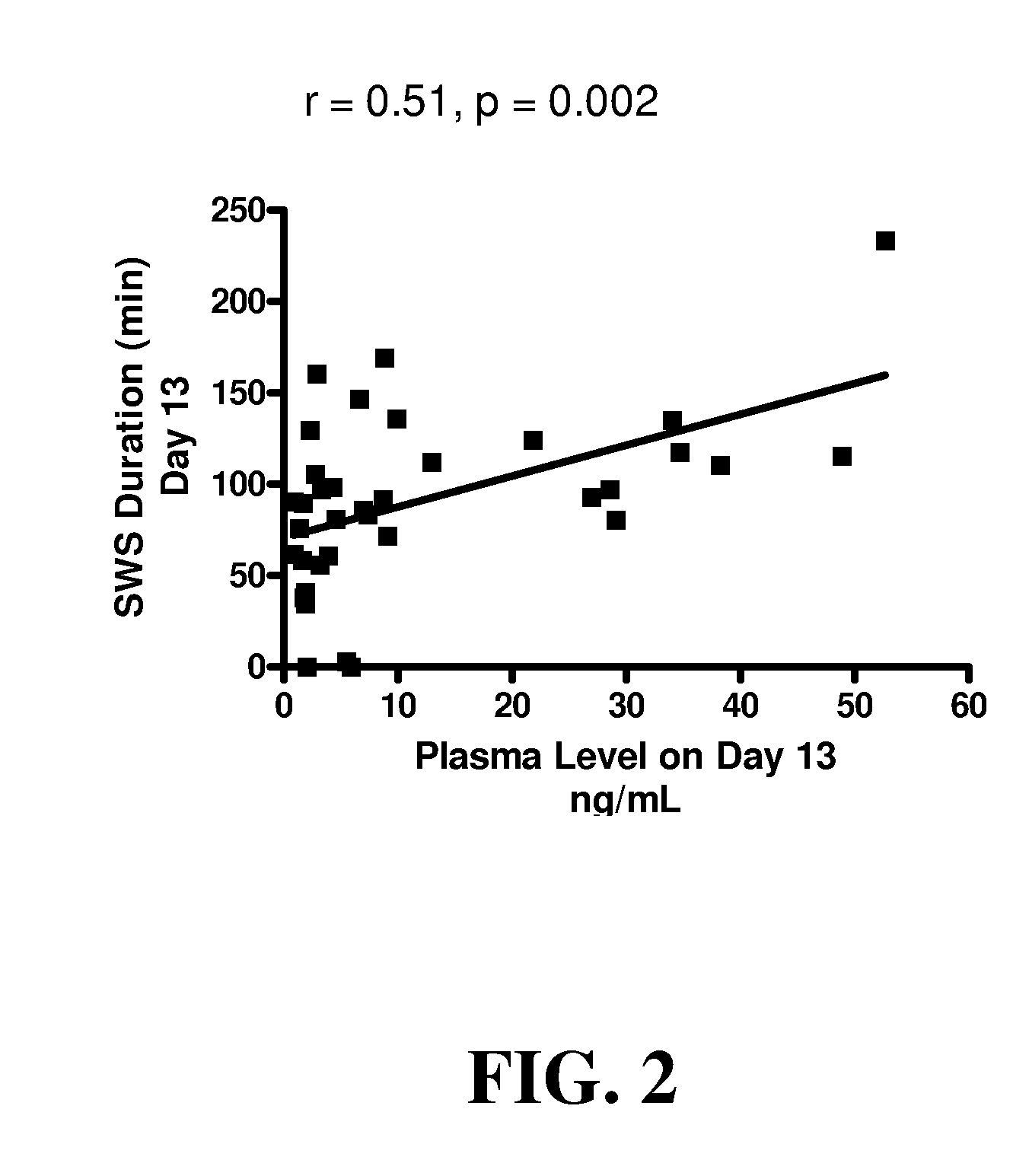Use of 4-amino-piperidines for treating sleep disorders
- Summary
- Abstract
- Description
- Claims
- Application Information
AI Technical Summary
Benefits of technology
Problems solved by technology
Method used
Image
Examples
example 1
N-((4-Methylphenyl)methyl)-N-(piperidin-4-yl)-N′-phenylmethylcarbamide (26HCH65)
[0638] To a solution of commercially available tert-butyl 4-oxo-1-piperidine carboxylate (1.75 g, 8.8 mmol) and 4-methylbenzylamine (970 mg, 8.0 mmol) in methanol (7 ml) was added acetic acid in methanol (1 M, 6.7 ml) followed by NaCNBH3 in methanol (0.3 M, 30 ml). The resulting solution was stirred at room temperature. After 20 h, water (5 ml) was added, and the mixture was stirred for 1 h before it was concentrated. Flash chromatography in dichloromethane:methanol 10:1 gave tert-butyl 4-(4-methylphenyl)methyl)amino-piperidine carboxylate. Yield: 2.4 g, 98%. To a solution of tert-butyl 4-(4-methylphenyl)methyl)amino-piperidine carboxylate (800 mg, 2.63 mmol) in dry dichloromethane (20 ml) was added benzylisocyanate (0.65 ml, 5.26 mmol). The solution was stirred at room temperature. After 48 h, an excess of 2-dimethylaminoethylamine was added. The mixture was stirred for another 24 h, before it was conc...
example 2
N-((4-Methylphenyl)methyl)-N-(1-(2-methylpropyl)piperidin-4-yl)-N′-phenylmethylcarbamide (26HCH66-02)
[0639] The product from example 1 above (20 mg, 0.06 mmol)was dissolved in abs. ethanol (2 ml). 2-Methylpropionaldehyde (0.08 ml, 0.6 mmol)was added followed by solid-supported borohydride (150 mg, 2.5 mmol / g resin; Aldrich 32,864-2). The mixture was shaken at room temperature. After 48 h, the resin was filtered off and acetic anhydride (0.02 ml, 0.2 mmol)was added to the organic solution. After 24 h, the mixture was concentrated and redissolved in methanol (2 ml). The solution was added on to a column carrying strongly acidic cation exchange resin (0.3 mmol / g resin), which was washed with methanol (3×6 ml), and eluted with 10% NH3 in methanol, and concentrated to give the title compound. IR: 1640, 1185, 1110 cm−1; LC-MS: (M+H)+ 394.2, tr 5.60 min.
example 3
N-(1-((2-Bromophenyl)methyl)piperidin-4-yl)-N-((4-methylphenyl)methyl)-N′-phenylmethylcarbamide (26HCH66-03)
[0640] The product from example 1 above (20 mg, 0.06 mmol) was dissolved in abs. ethanol (2 ml). 2-Bromobenzaldehyde (0.07 ml, 0.6 mmol) was added followed by solid-supported borohydride (150 mg, 2.5 mmol / g resin; Aldrich 32,864-2). The mixture was shaken at room temperature. After 48 h, the resin was filtered off and acetic anhydride (0.02 ml, 0.2 mmol) was added to the organic solution. After 24 h, the mixture was concentrated and redissolved in methanol (2 ml). The solution was added on to a column carrying strongly acidic cation exchange resin (0:3 mmol / g resin), which was washed with methanol (3×6 ml), and eluted with 10% NH3 in methanol, and concentrated to give the title compound. IR: 1635, 1180, 1110 cm−1; LC-MS: (M+H)+ 506.1, tr 8.37 min.
PUM
| Property | Measurement | Unit |
|---|---|---|
| Time | aaaaa | aaaaa |
| Mass | aaaaa | aaaaa |
| Mass | aaaaa | aaaaa |
Abstract
Description
Claims
Application Information
 Login to View More
Login to View More - R&D
- Intellectual Property
- Life Sciences
- Materials
- Tech Scout
- Unparalleled Data Quality
- Higher Quality Content
- 60% Fewer Hallucinations
Browse by: Latest US Patents, China's latest patents, Technical Efficacy Thesaurus, Application Domain, Technology Topic, Popular Technical Reports.
© 2025 PatSnap. All rights reserved.Legal|Privacy policy|Modern Slavery Act Transparency Statement|Sitemap|About US| Contact US: help@patsnap.com



